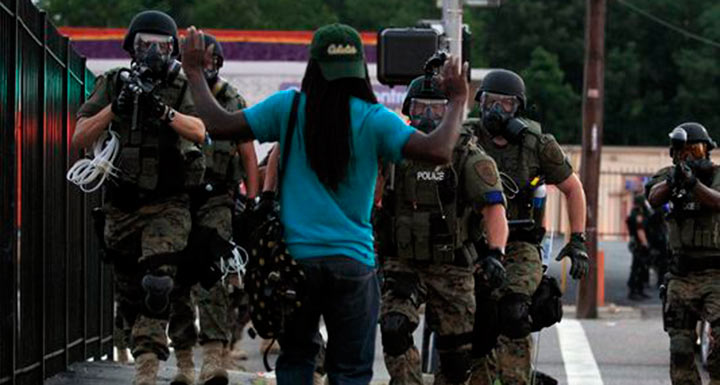
Pentagon fueled Ferguson confrontation
St. Louis County law enforcement agencies received twelve 5.56 millimeter rifles and six .45 caliber pistols from the Department of Defense between Aug. 2, 2010, and Feb. 13, 2013, a Missouri public safety official confirmed Thursday. Ferguson, Mo., is within St. Louis County. The Pentagon allows information on “tactical” equipment to be released only at a county level, so which police department(s) in the county received the weaponry is not available.
Pentagon fueled Ferguson Confrontation
The Pentagon might not have boots on the ground in Ferguson, Mo., where 18-year-old Michael Brown was shot by police on Saturday, but it does have wheels on the street.
Michelle McCaskill, media relations chief at the Defense Logistics Agency, confirms that the Ferguson Police Department is part of a federal program called 1033 that distributes hundreds of millions of dollars of surplus military equipment to civilian police forces across the United States. The materials range from small items, such as pistols and automatic rifles, to heavy armored vehicles such as the MRAPs used in Afghanistan and Iraq.
“In 2013 alone, $449,309,003.71 worth of property was transferred to law enforcement,” the agency’s website states.
According to McCaskill, the most recent transfer of military equipment from the Department of Defense to small Ferguson was in November and included two vehicles as well as a trailer and a generator. Details on the vehicles and their intended uses have not been released by the Pentagon. Information on any prior transfers is also unavailable.
A state public safety official told USA TODAY that the Pentagon does not allow detailed information on “tactical” equipment to be released at a police force level, only at a county level. According to a document provided by the official, police forces in the same county as Ferguson received advanced rifle sights and night vision equipment between 2012 and 2014.
There is no evidence that any such equipment has yet been used in the Brown case and its aftermath. But such “police militarization” is just one element of an often toxic relationship between minority communities and local police.
Since the creation of the 1033 program by Congress in the early 1990s, the program has distributed $4.3 billion of excess equipment, ranging from innocuous office supplies to bomb-disposing robots and other advanced technology. The flood of military supplies — along with the continuing drug war and grant programs from other federal agencies that provide military-style equipment — has pushed the culture of police forces far from its law-enforcement roots.
Indeed, the motto of the 1033 program is “From Warfighter to Crimefighter.”
So it is not a surprise that police officers often seem prepared for war. In Ferguson, that change is most dramatically revealed in the images of camouflage-wearing police officers with assault rifles, body armor and multiple extra magazines facing unarmed protesters with their hands preemptively raised in the air.
The disturbing trend of police militarization permits law enforcement agencies to view people in their communities as threats, rather than as citizens with rights, reports TheWashington Post’s Radley Balko, who has covered the militarization of the police extensively.
Elsewhere in Missouri, agencies participating in the 1033 program have acquired “aircraft (both fixed wing and rotary) and four-wheel drive vehicles (such as pickup trucks, blazers, ambulances and armored personnel carriers),” according to the state’s Department of Public Safety.
If there’s one thing a community in turmoil does not need is for anyone to turn up the heat as protesters and police face off and tempers simmer. But before a local police officer fired his first shot at the unarmed teen, the U.S. military helped make sure there was plenty of fuel to bring things to a boil.
David Mastio is the Forum Editor of USA TODAY, where Kelsey Rupp is a Collegiate Network Fellow.
The original headline on this column was, “Pentagon fueled Ferguson Confrontation.”

